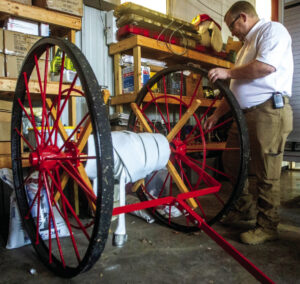Hitting the trail
Spectators watch with bated breath then cheer as cowboys and cowgirls alike mount bucking broncos, speed around barrels on horseback or skillfully execute pistol shoots from the backs of their equestrian counterparts at rodeos and specialized events. These equine sports and more are showcased at these events – but there is one sport that is not represented because of its extended nature.
Many people might not even be aware of the challenging sport of endurance riding and racing.
Vina resident Elizabeth Turbyfill has recently started competing in this sport and has placed first in the three competitions she has participated in so far.
“It’s a sport a lot of people don’t know about, but it’s hard and demanding,” Turbyfill said.
Races have different distance limits, Turbyfill explained. She has participated in races of 25-30 miles long with a time limit of six hours. Longer races can be 50, 55 or 100 miles long with time limits of 12-24 hours.
“I think it’s different than other equine sports when it comes to how meticulous they are about maintaining the care of the horses,” Turbyfill said. In races in which she has competed, three veterinary checkpoints – one at the beginning, middle and end – have required the horses to meet certain body conditions, like heart rate, to continue the route. She said the vets have long checklists they use to make sure the horses are in good condition to compete in the race.
“They have to be in good shape. If they weigh too much, they have a higher risk of having a heart attack. If they don’t weigh enough, that’s not good either,” Turbyfill said.
The horse she used in her first race April 21 at the Hodges Equestrian Park is named Warrior. He is an American saddle horse from South Haven, Miss. Warrior was in good shape, Turbyfill said, but broke a bone in his foot and hasn’t been able to compete since.
Turbyfill has since competed in races in Bankhead and Forest, Miss., on a mare named Fancy that she borrowed from Tina Cochran.
“Arabians tend to dominate the sport, but you see different breeds competing,” she said.
Her 4-year-old horse Chaos is a Tennessee Walking horse that she bought from an auction house. Turbyfill said he had never been handled, haltered or anything of the sort, and when she bought him he was underweight and in poor condition.
“He’s an easy keeper, but he’s lazy. If he doesn’t make a good endurance horse, he’ll definitely make a good lessons horse,” she said.
Butterbean is her third horse, a 4-year-old Morgan breed she adopted from a friend. She said he will need to lose weight and get in shape before she tries him at endurance riding.
Getting the horse in shape and building its trust is key for this sport and all equestrian sports, Turbyfill explained.
“You have to spend time with them. They’re herd animals, and they need to feel that connection. If you’re part of their herd, they’re more likely to want to please you,” she explained.
Turbyfill said she has always loved horses and animals of all kinds, even though her family didn’t have any horses while she was growing up. It wasn’t until the age of 13 that she first started working with horses. She started with English show jumping and then moved on to Western Drill, which is a Christian group in Colorado where she is from that teaches children how to ride.







